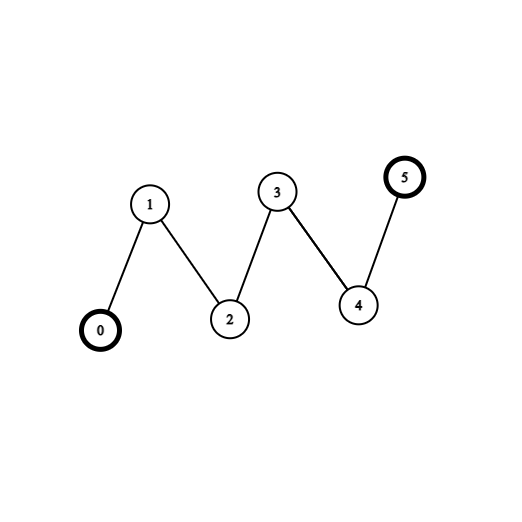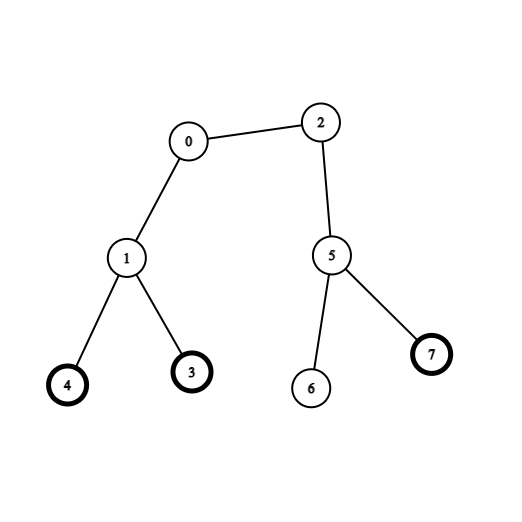给你一个 n 个节点的无向无根树,节点编号从 0 到 n - 1 。给你整数 n 和一个长度为 n - 1 的二维整数数组edges ,其中 edges[i] = [ai, bi] 表示树中节点 ai 和 bi 之间有一条边。再给你一个长度为 n 的数组coins ,其中 coins[i] 可能为 0 也可能为 1 ,1 表示节点 i 处有一个金币。
一开始,你需要选择树中任意一个节点出发。你可以执行下述操作任意次:
收集距离当前节点距离为 2 以内的所有金币,或者
移动到树中一个相邻节点。
你需要收集树中所有的金币,并且回到出发节点,请你返回最少经过的边数。
如果你多次经过一条边,每一次经过都会给答案加一。
示例 1:
**输入:** coins = [1,0,0,0,0,1], edges = [[0,1],[1,2],[2,3],[3,4],[4,5]]
**输出:** 2
**解释:** 从节点 2 出发,收集节点 0 处的金币,移动到节点 3 ,收集节点 5 处的金币,然后移动回节点 2 。
示例 2:
**输入:** coins = [0,0,0,1,1,0,0,1], edges = [[0,1],[0,2],[1,3],[1,4],[2,5],[5,6],[5,7]]
**输出:** 2
**解释:** 从节点 0 出发,收集节点 4 和 3 处的金币,移动到节点 2 处,收集节点 7 处的金币,移动回节点 0 。
提示:
n == coins.length1 <= n <= 3 * 1040 <= coins[i] <= 1edges.length == n - 1edges[i].length == 20 <= ai, bi < nai != biedges 表示一棵合法的树。
本题视频讲解 见【周赛 338】 25:04。
前置知识:拓扑排序 见【周赛 308】 21:55。
提示 1 去掉不包含金币的子树,访问其中任何一个点都毫无意义。
做法:从没有金币的叶子出发,跑拓扑排序。
注意,去掉这些子树后,某些原来不是叶子的节点会变成叶子。
提示 2 只需要考虑有金币的的叶子,因为不在叶子上的金币顺路 就能收集到。
提示 3 从有金币的的叶子出发,再次跑拓扑排序。在拓扑排序的同时,标记每个点入队的时间 time。
注意是入队的时间,不是访问到这个节点的时间。
叶子入队的时间为 0;
去掉这些叶子后,又产生了新的叶子 ,这些叶子入队的时间为 1;
去掉这些叶子后,又产生了新的叶子 ,这些叶子入队的时间为 2;
……
示例 2 如下图,数字表示节点入队的时间:
那么只要走到 time}[x]=2 的节点 x,就能收集到在叶子上的金币。
遍历所有边 x-y,如果满足 time}[x]\ge 2 且 time}[y]\ge 2(上图蓝色边),那么这条边需要恰好经过 2 次(因为需要回到出发点),答案加 2;如果不满足,则无需经过。
注:从任意被蓝色边连接的点出发,算出来的答案都是一样的。
[sol1-Python3] 1 2 3 4 5 6 7 8 9 10 11 12 13 14 15 16 17 18 19 20 21 22 23 24 25 26 27 28 29 30 31 32 33 34 35 36 37 38 39 class Solution : def collectTheCoins (self, coins: List [int ], edges: List [List [int ]] ) -> int : n = len (coins) g = [[] for _ in range (n)] deg = [0 ] * n for x, y in edges: g[x].append(y) g[y].append(x) deg[x] += 1 deg[y] += 1 q = deque() for i, (d, c) in enumerate (zip (deg, coins)): if d == 1 and c == 0 : q.append(i) while q: for y in g[q.popleft()]: deg[y] -= 1 if deg[y] == 1 and coins[y] == 0 : q.append(y) for i, (d, c) in enumerate (zip (deg, coins)): if d == 1 and c: q.append(i) if len (q) <= 1 : return 0 time = [0 ] * n while q: x = q.popleft() for y in g[x]: deg[y] -= 1 if deg[y] == 1 : time[y] = time[x] + 1 q.append(y) return sum (time[x] >= 2 and time[y] >= 2 for x, y in edges) * 2
[sol1-Java] 1 2 3 4 5 6 7 8 9 10 11 12 13 14 15 16 17 18 19 20 21 22 23 24 25 26 27 28 29 30 31 32 33 34 35 36 37 38 39 40 41 42 43 44 45 46 47 48 49 50 51 class Solution { public int collectTheCoins (int [] coins, int [][] edges) { int n = coins.length; List<Integer> g[] = new ArrayList [n]; Arrays.setAll(g, e -> new ArrayList <>()); var deg = new int [n]; for (var e : edges) { int x = e[0 ], y = e[1 ]; g[x].add(y); g[y].add(x); ++deg[x]; ++deg[y]; } var q = new ArrayDeque <Integer>(); for (int i = 0 ; i < n; ++i) if (deg[i] == 1 && coins[i] == 0 ) q.add(i); while (!q.isEmpty()) { int x = q.peek(); q.pop(); for (int y : g[x]) if (--deg[y] == 1 && coins[y] == 0 ) q.add(y); } for (int i = 0 ; i < n; ++i) if (deg[i] == 1 && coins[i] == 1 ) q.add(i); if (q.size() <= 1 ) return 0 ; var time = new int [n]; while (!q.isEmpty()) { int x = q.peek(); q.pop(); for (int y : g[x]) if (--deg[y] == 1 ) { time[y] = time[x] + 1 ; q.add(y); } } int ans = 0 ; for (var e : edges) if (time[e[0 ]] >= 2 && time[e[1 ]] >= 2 ) ans += 2 ; return ans; } }
[sol1-C++] 1 2 3 4 5 6 7 8 9 10 11 12 13 14 15 16 17 18 19 20 21 22 23 24 25 26 27 28 29 30 31 32 33 34 35 36 37 38 39 40 41 42 43 44 45 46 47 48 49 50 51 class Solution {public : int collectTheCoins (vector<int > &coins, vector<vector<int >> &edges) int n = coins.size (); vector<vector<int >> g (n); int deg[n]; memset (deg, 0 , sizeof (deg)); for (auto &e: edges) { int x = e[0 ], y = e[1 ]; g[x].push_back (y); g[y].push_back (x); ++deg[x]; ++deg[y]; } queue<int > q; for (int i = 0 ; i < n; ++i) if (deg[i] == 1 && coins[i] == 0 ) q.push (i); while (!q.empty ()) { int x = q.front (); q.pop (); for (int y: g[x]) if (--deg[y] == 1 && coins[y] == 0 ) q.push (y); } for (int i = 0 ; i < n; ++i) if (deg[i] == 1 && coins[i]) q.push (i); if (q.size () <= 1 ) return 0 ; int time[n]; memset (time, 0 , sizeof (time)); while (!q.empty ()) { int x = q.front (); q.pop (); for (int y: g[x]) if (--deg[y] == 1 ) { time[y] = time[x] + 1 ; q.push (y); } } int ans = 0 ; for (auto &e: edges) if (time[e[0 ]] >= 2 && time[e[1 ]] >= 2 ) ans += 2 ; return ans; } };
[sol1-Go] 1 2 3 4 5 6 7 8 9 10 11 12 13 14 15 16 17 18 19 20 21 22 23 24 25 26 27 28 29 30 31 32 33 34 35 36 37 38 39 40 41 42 43 44 45 46 47 48 49 50 51 52 53 54 55 56 57 58 59 60 func collectTheCoins (coins []int , edges [][]int ) int ) { n := len (coins) g := make ([][]int , n) deg := make ([]int , n) for _, e := range edges { x, y := e[0 ], e[1 ] g[x] = append (g[x], y) g[y] = append (g[y], x) deg[x]++ deg[y]++ } q := make ([]int , 0 , n) for i, d := range deg { if d == 1 && coins[i] == 0 { q = append (q, i) } } for len (q) > 0 { x := q[0 ] q = q[1 :] for _, y := range g[x] { deg[y]-- if deg[y] == 1 && coins[y] == 0 { q = append (q, y) } } } for i, d := range deg { if d == 1 && coins[i] == 1 { q = append (q, i) } } if len (q) <= 1 { return } time := make ([]int , n) for len (q) > 0 { x := q[0 ] q = q[1 :] for _, y := range g[x] { deg[y]-- if deg[y] == 1 { time[y] = time[x] + 1 q = append (q, y) } } } for _, e := range edges { if time[e[0 ]] >= 2 && time[e[1 ]] >= 2 { ans += 2 } } return }
复杂度分析
时间复杂度:O(n),其中 n 为 coins 的长度。
空间复杂度:O(n)。
思考题 如果把题目中的 2 换成 0,1,2,3,\cdots, n-1,你能把这些情况对应的答案全部算出来吗?
见本题视频讲解。
相似题目


